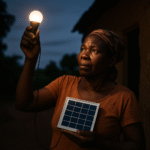For all the talk of solar revolutions and just transitions, one truth still defines Africa’s energy story: the continent’s access to power depends on its access to affordable capital. The latest International Energy Agency (IEA) report, Financing Electricity Access in Africa (2025), lays the issue bare: Africa is not short of sunlight or ambition, but of financing that fits its realities.
The Financing Paradox
Across sub-Saharan Africa, nearly 600 million people remain without electricity, while those connected often endure erratic supply or high tariffs. Yet the IEA estimates that Africa receives less than one-third of the annual investment required to reach universal access by 2030.
The numbers tell a story of structural imbalance: although the continent needs roughly $25–30 billion each year, actual flows hover around $9–10 billion. The result is a patchwork of progress, cities light up while rural communities remain trapped in the dark.
The paradox is clear. Even as global climate finance accelerates, the cost of capital for African energy projects remains up to four times higher than in advanced economies. Local developers often borrow at 12–20 percent interest, compared with 4–6 percent in OECD markets. This single factor inflates the cost of power generation and pushes electrification targets further out of reach.
“Reducing the cost of capital to global averages could cut project costs by 15–25 percent and bring electricity to an additional 40 million people,” the IEA notes, a figure that underscores how finance, not technology, is Africa’s real bottleneck.
The True Cost of Power
Electricity access is not just about building lines or installing panels; it’s about sustaining systems. For many African countries, the financial architecture itself is the problem.
Most projects rely on foreign-currency loans, which means that every depreciation of the naira, cedi or shilling deepens repayment burdens. Even when concessional funds are available, disbursement delays and complex approval processes make them difficult to deploy.
Meanwhile, risk perceptions, often outdated, keep international investors cautious. The report argues that risk premiums applied to African projects far exceed actual market risk, reflecting a finance system still shaped by stereotypes rather than data.
The consequences are immediate. Mini-grid developers scale down, rural electrification agencies stall, and public utilities spiral further into debt. What should be a virtuous cycle of investment and growth becomes a vicious loop of underfunding, inefficiency, and lost opportunity.
Public Finance vs. Private Capital
Who should pay for universal access, and on what terms?
The IEA’s report points to a widening divide between private-sector dynamism and public-sector responsibility.
Private investors have brought innovation to solar home systems, battery storage, and micro-grids. Yet they gravitate toward high-income, low-risk markets, urban or peri-urban zones where users can pay. Public finance, meanwhile, is left to underwrite fragile and low-return environments: remote villages, conflict-affected regions, and poor communities that need power the most.
This uneven geography of finance mirrors a deeper inequity. When the private sector dominates the profitable end of the spectrum and public institutions absorb the risk, universal access becomes a moving target.
The report calls for a “strategic blend of public and private capital”, one that channels concessional finance toward risk reduction, not just subsidy. Instruments such as first-loss guarantees, local-currency hedging, and regional development funds could help rebalance the system.
“De-risking cannot mean off-loading risk onto the public,” an African energy regulator told the IEA during consultations. “It must mean building institutions that manage risk collectively.”
Gender and Inclusion: The Missing Dimension
Energy poverty is not gender-neutral. Women bear the greatest burden when electricity is scarce, from unpaid care work to lost income in informal enterprises. Yet the IEA finds that women-led businesses face a $42 billion financing gap in energy access sectors.
Female entrepreneurs running solar distribution networks, clean-cooking start-ups, or community mini-grids often lack collateral, credit history, or access to foreign-currency loans. The absence of gender-lens financing perpetuates exclusion, not empowerment.
Bridging this gap requires more than token inclusion. It calls for dedicated credit lines, gender-responsive procurement, and partnerships with microfinance institutions. As the IEA notes, closing the financing gap for women could unlock productivity gains that ripple through entire local economies.
De-Risking Without Debt
The IEA’s most urgent recommendation is deceptively simple: reduce borrowing costs without increasing debt.
This means shifting from debt-centric instruments to grants, guarantees, and blended models that crowd in private investment without trapping governments in repayment cycles.
For example, the report models that supply-side grants covering 30 percent of mini-grid costs and 50 percent of solar home systems could expand access to 110 million people. Crucially, this would still leave room for private operators, just within fairer terms of participation.
Local-currency financing is another pillar. If regional banks can lend in naira, cedi, or shilling, developers can hedge currency risk at source. The African Development Bank’s proposed Local Currency Blended Finance Platform, together with initiatives from Africa50 and the African Finance Corporation, are steps in this direction.
These tools redefine what de-risking means: not transferring risk, but transforming it.
The Politics of Power
Beneath the spreadsheets lies a political economy question: who controls energy finance?
Much of Africa’s energy transition remains shaped by external agendas, whether through conditional loans, donor-driven projects, or euro- and dollar-denominated contracts.
This dependence has real costs. When global interest rates rise, Africa’s energy future becomes more expensive overnight. As one IEA analyst told Energy Transition Africa, “the world’s poorest region effectively pays the highest price for its cleanest ambitions.”
Reversing this equation will require more than project-level innovation. It demands regional financial sovereignty, institutions that can mobilise domestic savings, issue green bonds, and reinvest surpluses locally. The report’s section on “Building African Financial Architecture” is a call to build resilience, not just infrastructure.
Lessons for Policymakers
- Reduce the cost of capital. Align macroeconomic stability, credit ratings, and governance reforms with investor confidence.
- Use concessional finance strategically. Channel grants toward risk reduction and social inclusion, not perpetual subsidy.
- Prioritise data transparency. Reliable power-sector data lowers perceived risk and improves pricing accuracy.
- Integrate gender. Every major fund should include gender-responsive criteria in its investment framework.
- Develop regional capital markets. Local-currency green bonds and regional guarantees can buffer global volatility.
Together, these steps form the scaffolding of what the IEA calls “affordable, just and sustainable energy access.”
A Path Forward
Africa’s power future will not be decided by technology alone. It will hinge on how finance is structured, who bears risk, and whose currency counts. The Financing Electricity Access in Africa report closes with a stark reminder: without new models, 2030’s universal-access target will slip to 2045.
The moral implication is impossible to ignore. Electricity is not charity; it is infrastructure for dignity. Financing it fairly is both a development necessity and a justice imperative.
If Africa can harness local capital, streamline concessional funding, and finally lower the cost of power, the continent may yet illuminate its future on its own terms.




Pingback: Africa’s Clean Energy Promise: Between Policy Progress and People’s Patience - Energy Transition Africa